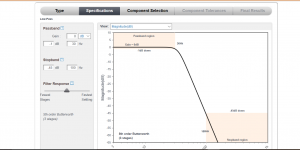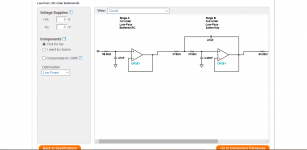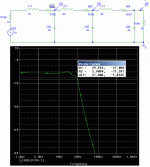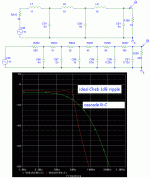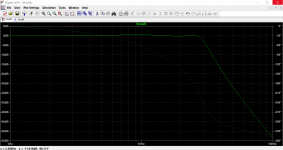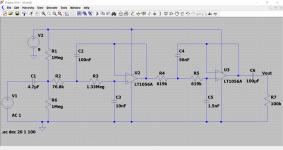Hi,
Could someone give me a little help here; My friend needs passive line-level xo for his HT (sofa shaker, don't know what it is in english..). Otherwise it wouldn't be problematic, but he needs -48db slope from 30hz. So freqs under 30hz only goes through and then steep slope down. Is it as simple as 8 resistors and 8 caps, like cloning 1st order filters next to each others? Any idea for correct values? DSP etc are not an option, way too overkill for this purpose.
Thanks!
Could someone give me a little help here; My friend needs passive line-level xo for his HT (sofa shaker, don't know what it is in english..). Otherwise it wouldn't be problematic, but he needs -48db slope from 30hz. So freqs under 30hz only goes through and then steep slope down. Is it as simple as 8 resistors and 8 caps, like cloning 1st order filters next to each others? Any idea for correct values? DSP etc are not an option, way too overkill for this purpose.
Thanks!
You are going to need to go active to do this satisfactorily.
Have a play with this:
Filter Wizard | Analog Devices
Have a play with this:
Filter Wizard | Analog Devices
Attachments
You need to specify the output impedance of whatever is driving the filter input (that may not be needed if it's low enough, and it usually is), and the input impedance of the amp the filter is working into. Also, a passive filter in all probability will reduce the level at the amp input somewhat.
Whoops, Mooly's right, I was thinking 24 dB slope which would be doable, but not 48 dB slope. Active is the only reasonable way to do that.
Mike
Whoops, Mooly's right, I was thinking 24 dB slope which would be doable, but not 48 dB slope. Active is the only reasonable way to do that.
Mike
Last edited:
There are lots of problems doing a passive high order filter which is what Michael alluded to above. A passive would interact massively with the input impedance of the stage it has to drive.
I'll have think later because as this is not for audio (so ultimately absolute quality is unimportant) then it might be possible to come up with something 'outside the box'.
I'll have think later because as this is not for audio (so ultimately absolute quality is unimportant) then it might be possible to come up with something 'outside the box'.
A couple of these circuits in series, a cheap TL072 or similar opamp, and a cmoy style virtual ground will work well.
Online Calculator .:. Sallen Key Lowpass Filter
Online Calculator .:. Sallen Key Lowpass Filter
There are lots of problems doing a passive high order filter which is what Michael alluded to above. A passive would interact massively with the input impedance of the stage it has to drive.
I'll have think later because as this is not for audio (so ultimately absolute quality is unimportant) then it might be possible to come up with something 'outside the box'.
I had a play for curiosity (simulation) using a mix of R/C and L and nothing comes close to the active arrangement. It needn't be complex, a quad opamp or a couple of duals and a few passives and its job done. Depending on the levels involved, operation from a single 9 v battery could be feasible.
Active filtering is the only real way to go
Unless you just build passive speaker level filter, using transformers for very high L inductors (big, heavy and $$$)
It would just be easier to utilise a subwoofer output from HT receiver, and then add a 2nd order passive speaker level filter to increase the slope/attenuation
You could also use line level 2nd order in addition to Subwoofer output n the same way, but you will have to be aware of loading the input and insertion loss
Unless you just build passive speaker level filter, using transformers for very high L inductors (big, heavy and $$$)
It would just be easier to utilise a subwoofer output from HT receiver, and then add a 2nd order passive speaker level filter to increase the slope/attenuation
You could also use line level 2nd order in addition to Subwoofer output n the same way, but you will have to be aware of loading the input and insertion loss
Last edited:
> sofa shaker, don't know what it is in english..
Butt shaker, butt kicker, seat shaker, and sofa-shaker.
> You won't get a good sharp 'knee' with a passive solution.
The filter alone can be as sharp as desired, L-C filtering was mature 80 years ago. There are even good online calcs: LC Filter Design
Some issues.
Classic theory is simplest when the filter is designed between *matched* impedances. This implies 6dB loss in the passband. You can often find 6dB reserve gain in an existing audio system; if not, there will be "an active element" (booster amp) which may dull the apparent attraction of pure-passive.
At low-low audio, chokes are highly imperfect. They have large resistance. While some resistance can be designed into the filter, the trade-off seems to be increased insertion loss, more need for a (active) booster-amp.
I used the calc to figure a lossless filter; the shape was exact and loss was 6dB. Then I added estimated values of series resistance for chokes these values. Curve went astray. Some tinkering got a little better, at increased insertion loss.
Now look at these values. The caps are not-small, bipolar, and good tolerance. The chokes, to get low-enough resistance, must be large. These are essentially 5W-10W tube-amp transformers. And not stock values, so probably custom-wound.
The one power transformer for an active filter will be smaller than any of the three iron lumps for the "passive" solution, which still needs a booster-amp. And little 12V transformers are cheap to free.
Butt shaker, butt kicker, seat shaker, and sofa-shaker.
> You won't get a good sharp 'knee' with a passive solution.
The filter alone can be as sharp as desired, L-C filtering was mature 80 years ago. There are even good online calcs: LC Filter Design
Some issues.
Classic theory is simplest when the filter is designed between *matched* impedances. This implies 6dB loss in the passband. You can often find 6dB reserve gain in an existing audio system; if not, there will be "an active element" (booster amp) which may dull the apparent attraction of pure-passive.
At low-low audio, chokes are highly imperfect. They have large resistance. While some resistance can be designed into the filter, the trade-off seems to be increased insertion loss, more need for a (active) booster-amp.
I used the calc to figure a lossless filter; the shape was exact and loss was 6dB. Then I added estimated values of series resistance for chokes these values. Curve went astray. Some tinkering got a little better, at increased insertion loss.
Now look at these values. The caps are not-small, bipolar, and good tolerance. The chokes, to get low-enough resistance, must be large. These are essentially 5W-10W tube-amp transformers. And not stock values, so probably custom-wound.
The one power transformer for an active filter will be smaller than any of the three iron lumps for the "passive" solution, which still needs a booster-amp. And little 12V transformers are cheap to free.
Attachments
Try here: Line Level Crossovers. Their lowpass filters only go to 50Hz, but they will make custom values for you.
For comparison:
An ideal (no coil resistance) Chebyshev filter
A best-quick-guess R-C filter which (eventually!) slopes 48dB/octave.
Note that the R-C filter gives less 10Hz-30Hz "kick", and a lot more 50Hz-300Hz "audio" which conflicts the stereo image from your audio speakers. (When Barry White sings, his low notes come from your butt, not your audio speakers, because Haas.)
An ideal (no coil resistance) Chebyshev filter
A best-quick-guess R-C filter which (eventually!) slopes 48dB/octave.
Note that the R-C filter gives less 10Hz-30Hz "kick", and a lot more 50Hz-300Hz "audio" which conflicts the stereo image from your audio speakers. (When Barry White sings, his low notes come from your butt, not your audio speakers, because Haas.)
Attachments
And that´s the crux of the problemThanks for your many replies! I guess going active wouldn't hurt then, just haven't even a smallest idea how to actually build itmaybe he just should go with miniDSP.
But hey, I guess you can simply buy ready made.
12 dB/oct are common as dirt, I bet 24db/oct ones are easy to find ... just cascade as many as needed for desired slope.
Not the most elegant solution but miles ahead of the crude original idea.
Plus probably some +/-15V supply or even "stealing" them from power amplifier ... current needs are nil and easily fed from simplest Zener regulators.
Something like this could be made using a single 8 legged opamp (TL062?) and a 9 volt battery. Some of the resistor values can be approximated to preferred values at the expense of a little deterioration in performance.
Attachments
In a 2-minute search, I found *one* 24dB/oct board. It is mono in, 3-way out. It can be ordered stock down to 60Hz, but if you open the instruction manual it has a link to their page to compute any frequency.
While it is "wasteful", you could get two boards, send to the input of one, take the Sub out to the input of another, and get a 48dB/oct filter.
Because this is not an ideal (calculated all together) filter the response will be "off". I believe it would be sufficient to calculate for "35Hz", then the actual -3dB point will be near 30Hz.
The answer then is eight 214391 Ohm (215K 1%) resistors. If the company won't supply them with the board (they may not stock values for real-low crossover) a little more than a dollar (plus shipping) buys them from Mouser (probably similar in your market). The opamps are TL0 types so will be fine with this value.
While it is "wasteful", you could get two boards, send to the input of one, take the Sub out to the input of another, and get a 48dB/oct filter.
Because this is not an ideal (calculated all together) filter the response will be "off". I believe it would be sufficient to calculate for "35Hz", then the actual -3dB point will be near 30Hz.
The answer then is eight 214391 Ohm (215K 1%) resistors. If the company won't supply them with the board (they may not stock values for real-low crossover) a little more than a dollar (plus shipping) buys them from Mouser (probably similar in your market). The opamps are TL0 types so will be fine with this value.
> sofa shaker, don't know what it is in english..
> You won't get a good sharp 'knee' with a passive solution.
The filter alone can be as sharp as desired, L-C filtering was mature 80 years ago. There are even good online calcs: LC Filter Design
Fair enough. I was thinking cascaded RC sections and not considering inductive solutions.
Something like this could be made using a single 8 legged opamp (TL062?) and a 9 volt battery. Some of the resistor values can be approximated to preferred values at the expense of a little deterioration in performance.
I like this solution, but if the OP is after 48dB/Octave roll off then cascading two such circuits would work a treat.
In fact I think you may be able to simplify further, with two cascaded RC ahead of the first Op Amp stage and Making the first two stages 3rd order sallen key, last stage 2nd order.
It only saves one op amp (or half TL072/62)
I wonder (never tried) if I can also add two cascaded RC in the NFB loop, instead of one, to make a single stage 4th order?
probably not
I've not messed with MFB filters, can they achieve a 4th order response with a single stage?
Filter matching or sharpness of knee isn't even that important to the OP spec.
To be totally honest, I'd just simplify scope: 2nd to 4th order at 20 Hz instead.
Sofa shaker or exciters, well they are supposed to emulate the big cinema sound system. Liver resonances at 7Hz with cannon fire , earthquakes etc. But large systems like that WILL rattle your flesh at 100Hz or more (think above 12th fret electric bass guitar)
If you just want rumble and infra Sonics then Fc = 20 Hz makes more sense to me. A lower order filter becomes more acceptable too, despite the bleedthrough of higher frequencies that you (OP) perceive as detrimental.
Last edited:
- Status
- This old topic is closed. If you want to reopen this topic, contact a moderator using the "Report Post" button.
- Home
- Source & Line
- Analog Line Level
- Passive line level - 48db low pass filter
